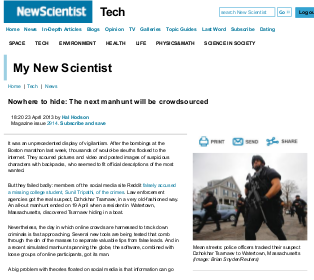Nowhere to hide: The next manhunt will be crowdsourced
New Scientist 2914, 23 April 2013 (free registration required) describes our proyect Veri.ly:
 ... A big problem with theories floated on social media is that information can go viral simply because it is popular, whether or not it is true. Patrick Meier of the Qatar Computing Research Institute (QCRI) in Doha is building Verily, a system that allows users to submit verification requests for information they are interested in. Each request prompts a crowd of online workers to set off into their networks to figure it out. The system gathers evidence for and against the claim, though it won't pass judgement.
... A big problem with theories floated on social media is that information can go viral simply because it is popular, whether or not it is true. Patrick Meier of the Qatar Computing Research Institute (QCRI) in Doha is building Verily, a system that allows users to submit verification requests for information they are interested in. Each request prompts a crowd of online workers to set off into their networks to figure it out. The system gathers evidence for and against the claim, though it won't pass judgement.
...By training machine learning algorithms on huge data sets, Meier is building up profiles of the classes of digital evidence that tend to be credible, and those that are not.
As an example, Meier points to a recent study of misinformation on Twitter after the 2010 Chilean earthquake. Carlos Castillo of the QCRI and colleagues showed that non-credible tweets tend to spark responses that question or rebuke them – a trait software can be trained to recognise. "Non-credible information propagates across the twittersphere leaving very specific ripples behind," says Meier. "You could absolutely start having a probability – a percentage chance that particular tweets are not credible."
Full article in New Scientist (free registration required) »


